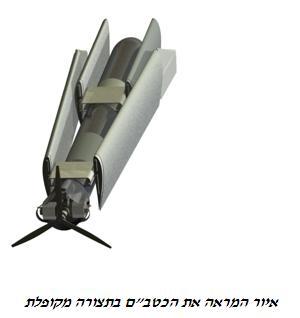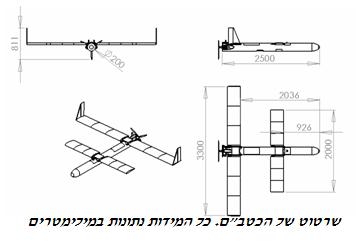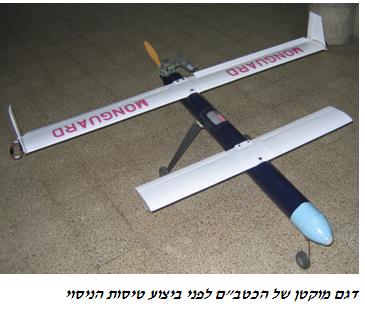The project was led by Dror Artzi Marfael, and nine students participated in it. The project was ambitious and included the design of a UAV designed to meet diverse and strict requirements, among them a good ratio between the weight of the vehicle and the weight of the prop, which was long in the air (a challenge in view of the limited amount of fuel), a launch from a pod - which dictated a complicated mechanism for folding and opening the wings, a flight room Maximum, landing with the help of a parachute and airbags and more
By Tal Inbar, "Hidan" correspondent for aviation and space affairs

The project was led by Dror Artzi Marfael, and nine students participated in it. The project was ambitious and included the design of a UAV designed to meet diverse and strict requirements, among them a good ratio between the weight of the vehicle and the weight of the prop, which was long in the air (a challenge in view of the limited amount of fuel), a launch from a pod - which dictated a complicated mechanism for folding and opening the wings, a flight room Maximum, landing with the help of a parachute and airbags, as well as leaving a significant empty volume inside the UAV - for the use of potential customers, who will be able to choose which components and systems to integrate into the vehicle.
The UAV designed by the student team is called MONGURD - acronym for Multi Operational National Guard. The maximum take-off weight is set at fifty kg, and the weight of the prop (two cameras - one day and the other for night photography) must not exceed 20 kg. The UAV is required to achieve the ability to be in the air for 10 hours, and to reach a flight height of 10000 feet.
The students chose the canard configuration - a combination of a large aerodynamic surface for the front, and in fact an additional wing. This configuration contributes to the stability of the tool and also enabled the special structure that folds into a storage and launch container. The launch container was designed to be installed in a variety of ground vehicles (such as a Hummer) or even to be carried into the air by another piloted vehicle, manned or any other UAV.
The students tested many aerodynamic configurations, before deciding on the final configuration. They faced many challenges - including decisions regarding the location of the fuel tanks, performing an optimal calculation of the center of gravity (which changes during flight due to fuel consumption or dropping weapons from the UAV) and, as mentioned, the rapid deployment mechanism of the vehicle's wings after it is launched from the storage tank and launched by a rocket engine.
The vehicle has an impressive wingspan of 3.3 meters (the front wing has a 2 meter span) and is driven by a piston engine mounted in its rear. The UAV has two cameras - one is located in the nose and the other is housed inside the body, and is pulled out downwards. The camera comes back to the body before the vehicle lands - in order to protect it.
As part of the work on the project, a miniature model of the UAV was built and several flights were made in it. It should be noted that many systems that were supposed to be installed in the real vessel were not installed in the model. Due to an engine failure, the experimental plane crashed in a way that prevented its presentation at the conference.
This student project presented advanced concepts in high school unmanned aerial vehicles, and met a particularly pressing time and budget constraint. The aeronautics and space engineering students demonstrated the application of the knowledge learned during their studies at the Technion, and showed the ability to manage a complex project in a short time. Although the designed UAV remains only an idea, it has the potential to present an interesting field in the development of similar tools in the future, and it also shows the very high professional level demonstrated by the Technion students.



One response
Go forth and succeed. Indeed the Jewish mind does not deceive. Emphasis must now be placed, among other things, on the development of micro-UAVs the size of birds that can identify those wanted to transmit the information in real time and be guided to hit the terrorist target. These suicide UAVs will be extremely cheap, it will be possible to operate them 24/365 in the thousands, to monitor all of Gaza and the south Lebanon, to carry out targeted elimination and any other operational activity, to release the manned helicopters and to remove our soldiers from the range of danger. The correct war strategy today and in the future - remotely controlled robotics as the ultimate answer to terrorism and on the battlefield. Read about it on the "Empower Israel" website empower-israel.org.il